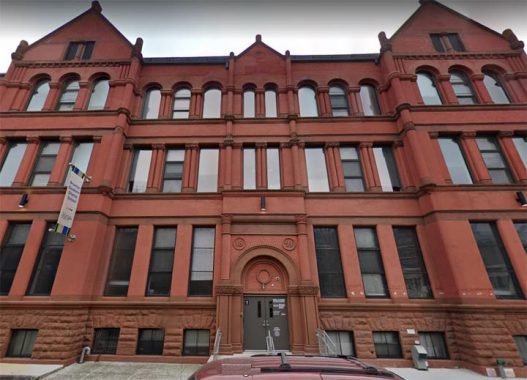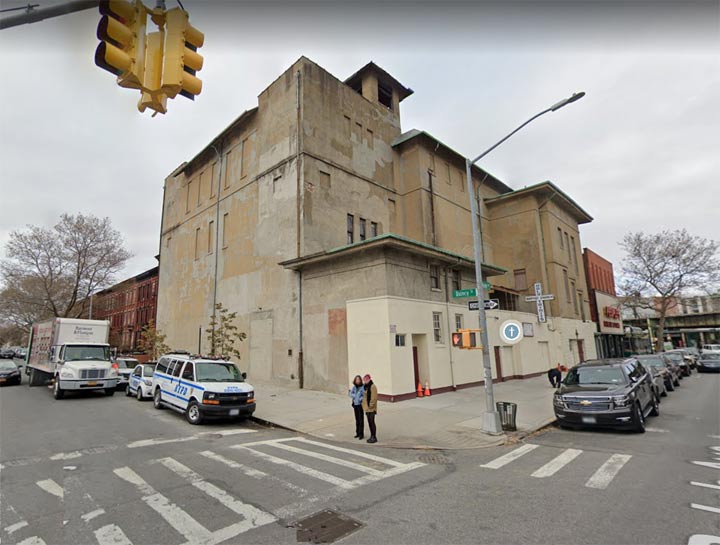Unfortunately I don’t get into eastern Bedford-Stuyvesant much, but a couple of structures at Ralph Avenue and Quincy Street recently attracted my notice. The dilapidated building shown above is the former Empire Theater, located just south of the Broadway El. The Empire opened in 1908 [Henry Brewster, architect] and was originally home to live vaudeville performances, consisting of a mix of comedy, drama and dance.
Fairly early on the Empire “devolved” into burlesque shows (less sophisticated fare and eventually, strippers) and then showed movies (you can see its marquee in Cinematreasures). The Empire closed in 1953. The building has hung on, severely dilapidated now, with the ground floor now hosting the Holy Trinity Baptist Church.

Just a few doors away on Quincy Street is the much better preserved former PS 26, now home to the Excelsior Charter School. There’s been a public school here or nearby since before the Civil War, with the first PS 26 arriving in 1856. The wood framed building soon proved inadequate, and a second school, a peaked 3-story brick building, opened at #838 Quincy near Ralph Avenue.
The area outgrew that school as well and the city of Brooklyn then deciced on a much more massive structure. This Romaneque revival dark brick school, designed by Brooklyn’s Superintendent of Buildings James W. Naughton, arrived in 1891. Naughton served as Superintendent of Buildings in the City of Brooklyn from 1874-1876, and became Superintendent of Buildings of Brooklyn’s Board of Education from 1879 until his death in 1898. He also designed Brooklyn’s Boys High School and Girls’ High School. All school buildings constructed in Brooklyn during that period were designed by Naughton, and most were in this Romanesque style. The older school building was maintained as an annex; but it burned down in 1950, with PS 26 also d=seriously damaged, requiring its closure, and causing overcrowding in nearby schools. The DOE responded by building a new school, PS 209, a couple of blocks away. PS 26 closed for good in 1988.
The indefatigable Montrose Morris has more at Brownstoner.
Ralph Avenue was named for prominent 19th Century Kings County landowner Ralph Patchen, who actually got two streets named for him. Ralph Avenue rumbles in a stop-start fashion from Bedford-Stuyvesant all the way south to Bergen Beach. Not only that, in Bushwick and Ridgewood, Menahan Street used to be called Ralph Street. Quincy Street was named for Massachusetts politician and Harvard University president Josiah Quincy. It is one of two streets in Brooklyn beginning with Q: Quentin Road is the other.
Check out the ForgottenBook, take a look at the gift shop, and as always, “comment…as you see fit.”
8/18/20


8 comments
I remember going to a shoe store on Broadway when I was a little child and my father parked near that theater. We could hea the music on the street it was so loud. It must have been the stripper show..
I got more looks at it on GSV. It’s in really bad shape, chances are the roof’s shot and the upper floors are largely beyond salvaging.
The roof is in two sections, the larger section is actually pretty OK shape based on satellite view while the smaller section(the part that you likely are looking at) is pretty bad and likely needs far too much renovation to make it salvagable…the church uses the theatre section so the actual theatre itself might be in OK shape with just a lot of interior restoration needed.
I always wanted to know why are there 2 sections of
Ralph Avenue????
The first photo is an emblem of a now dead city: idle & unattended NYPD vehicles blocked by a probably outward bound moving van. Meanwhile in AZ refugees from the west coast (& I mean CA, OR, & WA) arrive more & more frequently. Americans are voting with their feet when opportunity & public safety aren’t available to them. A sad testimony to failure.
Unfortunately, RedStateRefugee, far too often, those Americans continue to vote in their new locations for the same type of failure as in the places they left. (Present company excepted, I hope.)
I’ve passed by this structure a few times and never realized it used to be a theatre. Thanks for giving us a short trip to its history.
I think Francis Ford Coppola’s grandfather may have owned and operated this theater. From Italia Coppola’s Wikipedia page: “Born in New York City, she was one of six children of Anna (née Giaquinto) (1879-?) and composer Francesco Pennino (1880-1952), both of Naples, Italy.[7] Her father was a composer of Italian songs, an importer of Italian films and a movie theater owner. She was born in an apartment over the family’s Empire Theater in Brooklyn.” Her father died in 1952 so it checks out as far as years in operation. Here is the link to an obit that mentions it: https://www.sfgate.com/bayarea/article/Italia-Coppola-mother-of-filmmaker-2807695.php